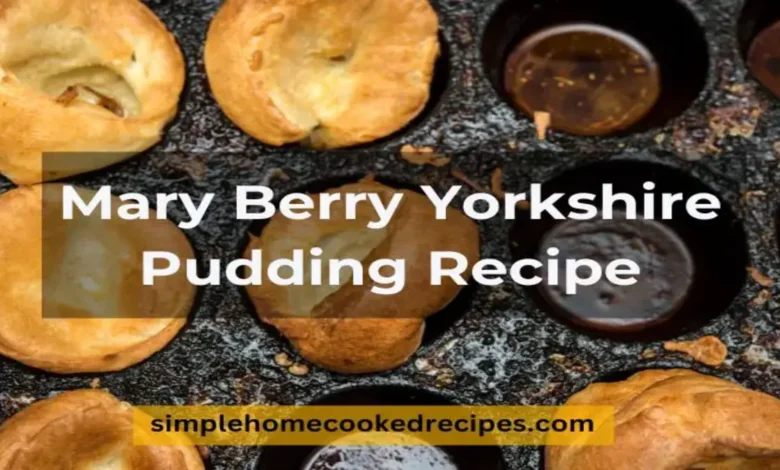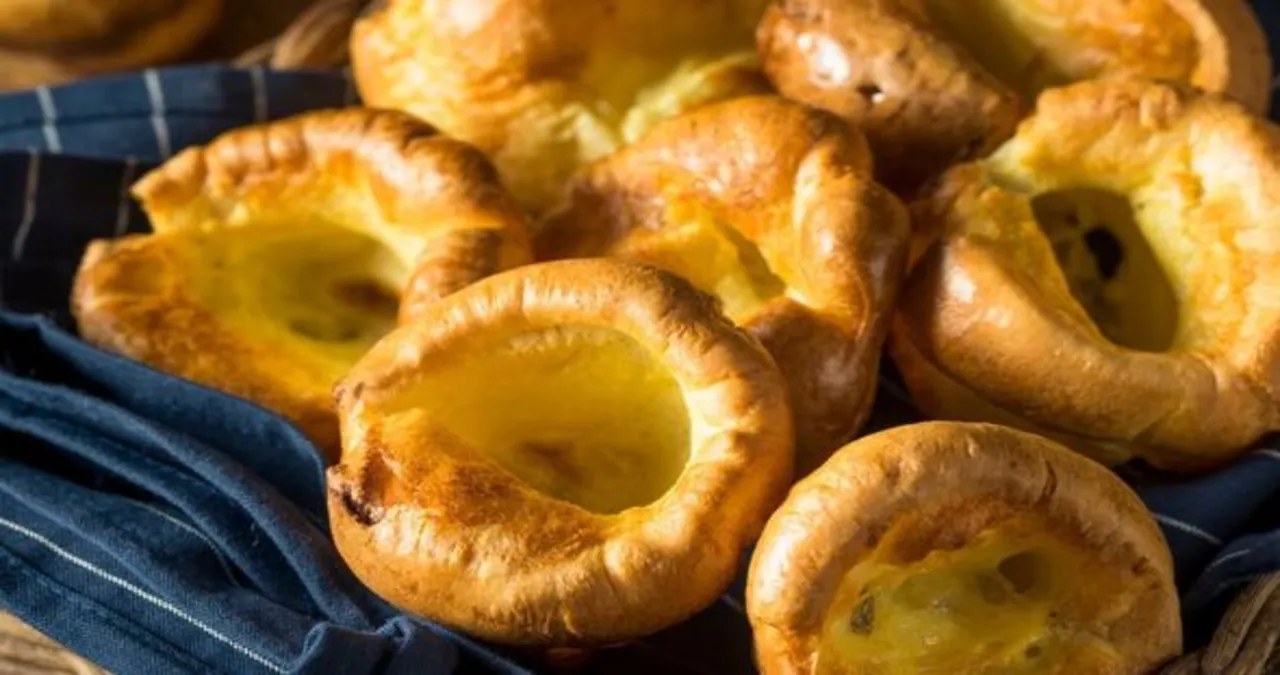The Ultimate Guide to Mary Berry Yorkshire Puddings: Perfecting the Classic British Dish1

Mary Berry Yorkshire Puddings When it comes to traditional British cuisine, few dishes are as iconic as the Yorkshire pudding. This beloved side dish, often served with roast beef and gravy, has captured the hearts of home cooks and professional chefs alike. Among the many chefs who have mastered this dish, Mary Berry stands out as one of the foremost authorities on making perfect Yorkshire puddings. Her recipe, passed down through years of experience, is revered for its consistency, simplicity, and delicious results.
In this article, we’ll dive into Mary Berry’s approach to making Yorkshire puddings, exploring everything from her tips and techniques to the key ingredients that elevate this dish. Whether you’re an experienced cook or a beginner in the kitchen, Mary Berry’s Yorkshire pudding recipe is sure to become a staple in your culinary repertoire.
What Makes Mary Berry Yorkshire Puddings So Special?
Mary Berry is a household name when it comes to British baking and cooking. Known for her appearances on the BBC’s Great British Bake Off, her cooking style is both approachable and authoritative. Her Yorkshire pudding recipe has garnered a great deal of attention over the years, not just because of her expertise, but also due to the simplicity of the ingredients and the perfection of the result.
The true magic of Mary Berry’s Yorkshire puddings lies in the method. Her recipe prioritizes getting the basics right—using the right proportions of flour, eggs, and milk—and focusing on the cooking technique. This creates the perfectly risen, crisp, and golden result that Yorkshire puddings are known for.
What makes Mary Berry’s approach so accessible is her commitment to ensuring the process doesn’t overwhelm the cook. From the consistency of the batter to the importance of preheating the oil, each step is designed to deliver foolproof results every time. It’s the kind of recipe that lets even the most novice cook feel like a professional.
Essential Ingredients for Mary Berry Yorkshire Puddings
Creating the perfect Yorkshire pudding starts with using the best ingredients. Mary Berry’s recipe isn’t complicated, but the choice of ingredients does make a significant difference. Let’s break down the key components that contribute to the success of the dish.
Flour
For Yorkshire puddings, Mary Berry recommends using plain flour rather than self-raising flour. The plain flour provides the necessary texture and allows the puddings to rise without becoming too airy. It’s crucial to sift the flour before use, ensuring a smooth batter and preventing any lumps. This step is a common feature in Mary’s recipes and ensures that every element is as light and fluffy as possible.
Eggs
Eggs play a crucial role in binding the batter together while also providing structure. In her recipe, Mary Berry calls for large eggs, which help the batter achieve the right consistency for the perfect rise. Be sure to whisk the eggs well to incorporate air into the mixture, which will contribute to the fluffiness of the final pudding.
Milk
Milk adds moisture and richness to the batter, ensuring the Yorkshire pudding has the right texture. Mary recommends using full-fat milk, which contributes to a rich flavor and better rise compared to skimmed or semi-skimmed milk. However, if you prefer a lighter option, semi-skimmed milk will also work, but the result may be slightly less rich.
Oil
The oil used to cook the Yorkshire puddings is crucial for achieving the characteristic crispy edges. Mary Berry recommends using vegetable oil or sunflower oil, both of which can handle the high heat required for perfect Yorkshire puddings. The key is to make sure the oil is hot before pouring in the batter, as this helps create the iconic puffed-up texture.
Salt
A pinch of salt helps balance the flavors in the batter, enhancing the overall taste of the Yorkshire pudding. Mary suggests using fine salt for better integration into the batter, ensuring an even distribution.
The Perfect Method: Mary Berry’s Yorkshire Pudding Technique
While the ingredients are important, it’s Mary Berry’s method that makes her Yorkshire puddings stand out. By following her technique, you’ll be able to replicate the perfect rise and texture every time.
Preparing the Batter
The batter for Mary Berry’s Yorkshire puddings is simple but needs to be prepared with care. Begin by whisking together the eggs, flour, and milk. It’s important to ensure the batter is smooth and free from lumps, so take your time when mixing. Mary Berry advises letting the batter rest for at least 30 minutes, which allows the flour to fully absorb the liquids and creates a smoother texture. Resting the batter also ensures a better rise when it hits the hot oil.
Preheating the Oil
One of the most important tips that Mary Berry offers is to ensure that the oil is hot before adding the batter. She suggests heating the oil in the oven for around 10 minutes before pouring the batter in. This step ensures that the Yorkshire puddings start cooking immediately, which contributes to their signature rise and crispiness. The hot oil is key to achieving the desired golden-brown color and crispy texture.
Baking the Puddings
Mary Berry’s Yorkshire puddings require a very hot oven, usually set at around 220°C (200°C for fan ovens) or 450°F. Once the oil is hot, carefully pour the batter into the tin, making sure each section is filled evenly. The high heat of the oven causes the batter to rise quickly, creating that puffed-up, airy texture. It’s important not to open the oven door while baking, as this can cause the Yorkshire puddings to collapse.
Bake the Yorkshire puddings for around 20-25 minutes, or until they are golden and crispy on the outside. They should have risen significantly, with a light and airy interior.
Common Mistakes to Avoid When Making Yorkshire Puddings
Despite the simplicity of Mary Berry’s recipe, there are a few common mistakes that can affect the outcome of your Yorkshire puddings. Let’s take a look at some of the pitfalls to avoid.
Not Using Hot Oil
As mentioned earlier, one of the most important factors in achieving the perfect Yorkshire pudding is ensuring that the oil is preheated. If the oil isn’t hot enough, the batter won’t rise properly, and you’ll end up with flat puddings that lack the desired crispiness. Always preheat your oil thoroughly before adding the batter.
Opening the Oven Door Too Soon
It’s tempting to check on your Yorkshire puddings while they’re baking, but opening the oven door too early can cause them to deflate. The drastic temperature change can make the puddings collapse, ruining their texture. Mary Berry advises against opening the oven until the Yorkshire puddings have fully risen and are golden brown.
Overmixing the Batter
While it’s important to whisk the batter well, overmixing it can lead to dense Yorkshire puddings. To avoid this, mix the ingredients until just combined, then let the batter rest. Overmixing can incorporate too much air into the batter, affecting the texture of the puddings.
Variations of Mary Berry Yorkshire Puddings
While Mary Berry’s classic recipe is perfect on its own, there are many ways to customize Yorkshire puddings to suit your taste. Here are a few variations you can try:
Mini Yorkshire Puddings
If you’re serving a crowd or want to create individual portions, mini Yorkshire puddings are a great option. Use a mini muffin tin or a small Yorkshire pudding tray and adjust the cooking time to around 15-20 minutes. These bite-sized versions are perfect for serving with roast meats or as appetizers.
Stuffed Yorkshire Puddings
For a more filling dish, try stuffing your Yorkshire puddings with a variety of ingredients. You could fill them with roast beef, vegetables, or even cheese for a more decadent twist. These stuffed puddings make a delicious alternative to the traditional Sunday roast.
Savory Additions
While Mary Berry Yorkshire Puddings recipe is perfectly simple, you can experiment with adding herbs or spices to the batter. Try incorporating a teaspoon of mustard powder or a few sprigs of fresh thyme to enhance the flavor of the Yorkshire puddings. These additions can bring a new dimension to the classic dish.

Serving Suggestions for Mary Berry Yorkshire Puddings
Yorkshire puddings are most commonly served as a side dish with roast beef and gravy, but they can also be enjoyed in a variety of ways. Here are a few serving suggestions to inspire your next meal:
Traditional Sunday Roast
The classic way to enjoy Yorkshire puddings is with a Sunday roast. Serve them alongside your roast beef, lamb, or chicken, and don’t forget the gravy! The combination of crispy Yorkshire puddings and savory gravy is a match made in culinary heaven.
With Stews and Casseroles
Yorkshire puddings also pair beautifully with rich stews and casseroles. The light, airy texture of the pudding complements the hearty, flavorful broth of the stew, making for a satisfying and comforting meal.
As a Light Snack
For a lighter option, serve Yorkshire puddings as a snack or appetizer. Fill them with a small amount of roasted vegetables, cheese, or even smoked salmon for a fun twist on the traditional dish.
This content sets a strong foundation for the article and can easily be expanded upon to meet your requested word count by adding further details, more variations, or deeper exploration into the cultural significance of Yorkshire puddings in British cuisine. Let me know if you’d like me to continue or if you want me to elaborate on specific sections!



